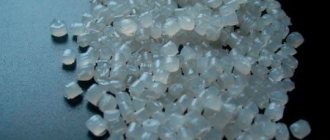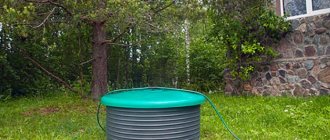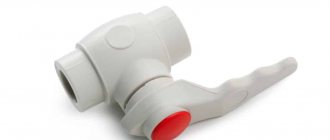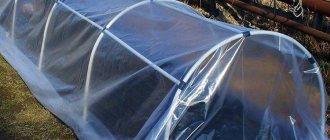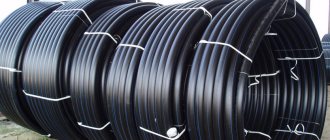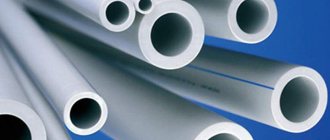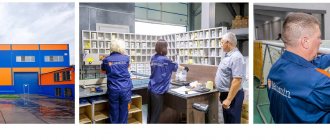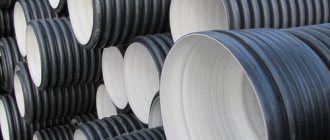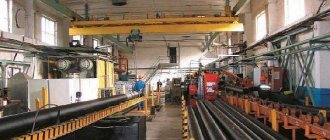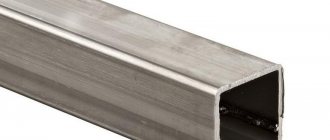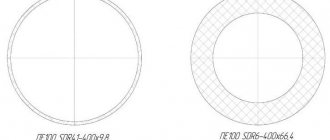Polypropylene pipes are in very high demand, which is not surprising, because in terms of their strength they are in no way inferior to their metal counterparts, and their production is much cheaper.
Polypropylene pipes have a number of very valuable advantages:
- high strength - unlike metal pipes, polypropylene pipes are not subject to corrosion or rotting;
- resistance to temperature changes - pipes can cope even with temperatures of +140°C and do not deform;
- polypropylene pipes are ideal for water - they do not affect its taste at all;
- the average service life of such pipes is on average 50 years;
- light weight - polypropylene pipes weigh significantly less than metal pipes, which simplifies their installation and transportation.
Why is it profitable to produce polypropylene pipes?
The widespread use of polypropylene pipes in pipelines for various purposes is caused by a number of parameters that are beneficial for each consumer:
- polypropylene pipes are very durable;
- impossibility of rust or rot;
- resistance to temperature fluctuations;
- the material does not react with water, therefore without affecting its taste;
- high performance characteristics (the service life of polypropylene pipes significantly exceeds that of steel pipes);
- low weight of products;
- low cost of polypropylene pipes and connecting fittings.
Read material on the topic: Wholesale of polypropylene pipes
Technological process
The main machine in which raw materials are processed and turned into a pipe is an extruder. If we consider in more detail the production technology of polypropylene pipes, it is necessary to highlight the following stages:
- Raw materials, which are chips or granules, are poured into the chamber. For the production of polypropylene pipes, you can use recycled material, which should be mixed with the main raw materials;
- The granules melt under the influence of gas or electric heaters at a temperature of 230–250 degrees. The plastic gradually turns into a kind of viscous substance. Inside, the walls of the machine for the production of polypropylene pipes are coated with Teflon, so the material does not stick to them;
- From the molten plastic, the extruder squeezes out products of the required diameter, 2.5 meters long. This is a completely autonomous process that occurs in an accelerated manner. The operator only monitors the operation of the equipment for the production of polypropylene pipes and sets the necessary parameters for it. The best models of machines produce up to 200 kg of products per hour;
- The blanks are cooled in a special bath, after which they keep their shape perfectly;
- At the last stage, the pipe is marked with the batch number and its production date. After this, the products are packaged and sent to the warehouse.
Scheme: production of polypropylene pipes
What raw materials does the production of polypropylene pipes and fittings require?
To launch a line for the production of polypropylene pipes, you need to select the necessary equipment and raw materials for their production. A copolymer is ideal as a raw material. The properties of this material make it one of the most popular in the polypropylene pipe production industry. A well-established production process will allow you to have a stable source of income.
When developing a business plan for the production of polypropylene pipes, it is worth considering the following points:
- optimal set of equipment for production;
- the price of renting or purchasing production space;
- cost of raw materials;
- operating expenses, etc.
The raw materials for the production of polypropylene pipes can be two types of material:
- Polypropylene homopolymer . It is used in the production of pipes for indoor sewer systems, as well as for certain types of fittings.
- Random polypropylene copolymer . The raw materials from this material have a plastic form due to the combination of polypropylene and ethylene in the required proportions. The material is excellent for the production of polypropylene pipes in heating and plumbing systems. But the raw materials for this production are exclusively of imported origin.
In addition to the above steps to launch a polypropylene pipe production line, it is also necessary to select a production methodology.
Read material on the topic: Types of polypropylene pipes
List of companies by federal district
Central Federal District
- • Valf-Rus
Vladimir region - • Polymer Pipe Plant
Moscow - • Yugtrubplast plant
Moscow region - • Ivanteevskaya Metallurgical Company
Moscow region - • Klimovsky Pipe Plant
Moscow region - • Kosmoplast
Moscow - • Lammin
Vladimir region - • LTC Svobodny Sokol
Lipetsk region - • Novomoskovsk Polymer Pipe Plant,
Tula region - • NPP Valok – Ch
Lipetsk region - • PPC Profile
Moscow region - About Aqua
Moscow region - • RTP
Moscow region - • Rus-Line
Moscow - • Sinicon
Moscow - • Sukreml Iron Foundry
Kaluga Region - • Tekhstroy
Moscow - • Truboplast
Tula region - • Chugun-F
Moscow - • Energotrupplast
Moscow region
Northwestern Federal District
- • Baltinox
Kaliningrad region - • Ikaplast
St. Petersburg - • Modern Pipeline Systems
St. Petersburg
Volga Federal District
- • Almetyevsk Pipe Plant
Tatarstan - • Arisplast
Tatarstan - • Vyksa Metallurgical Plant,
Nizhny Novgorod region - • Kstovo Pipe Plant,
Nizhny Novgorod region - • Ntz Tam-Po
Tatarstan - • Simple
Tatarstan - • Hemkor
Nizhny Novgorod region - • Holding-Plastpolymer
Tatarstan - • Cheboksary Pipe Plant
Chuvashia
Southern Federal District
- • Ventar
Krasnodar region - • Volzhsky Pipe Plant
Volgograd region - • Europolymer
Rostov region - • Italsovmont
Volgograd region - • Kubantechnoplast
Krasnodar region - • PC Stroyugkomplekt
Rostov region - • Production Company Dia
Volgograd region - • Tagmet
Rostov region
Ural federal district
- • Iceberg As
Sverdlovsk region - • Ozersky Power Plant Plant
Chelyabinsk region - • Pervouralsk Novotrubny Plant
Sverdlovsk region - • Seversky Pipe Plant
Sverdlovsk region - • Sinarsky Pipe Plant
Sverdlovsk region - • TZ Sibgazapparat
Tyumen region - • Chelyabinsk Pipe Rolling Plant
Chelyabinsk region
Siberian Federal District
- • Azp
Irkutsk region - • Plant Universal
Novosibirsk region - • Irkutsk Pipe Plant
Irkutsk region - • Omsk Pipe Insulation Plant,
Tomsk region - • Polymer
Kemerovo region
Far Eastern Federal District
- • Rainbow
Primorsky Krai - • Khabarovsk Pipe Plant
Khabarovsk Territory
Polypropylene pipe production technology: stages
The production process of polypropylene pipes is based on the ability of polymers to change their plasticity as a result of heating. To prevent the breakdown of molecular bonds, chemical catalysts are added to the material. The raw material heated to the required temperature takes on a plastic form (extrusion process). The big advantage of this production is that the entire process practically does not require human participation.
The entire technological chain, in which the raw material undergoes step-by-step processing, is as follows:
Stage 1 – heating the polymer . Raw material granules (this is the form in which raw materials are delivered to the manufacturer) are loaded into a production machine, which, under the action of high temperature, gives future pipes the required level of plasticity.
As the granules move from chamber to chamber, the temperature level increases, gradually increasing the plasticity of the material. The maximum heating level is set based on the purpose of the finished polypropylene pipe.
Stage 2 – extrusion process . At the exit from the outer chamber, the material takes on the desired shape. The entire process of this stage of production is easy to follow by taking as an example the production line: SJ 6533. The role of the extruder, in this case, is to separate a certain volume of raw material mass and place it in an area with high pressure. Under the influence of hydraulic equipment, the raw material is passed through a molding filter - a die (made from a material that is not susceptible to high temperatures and the influence of chemical reagents). The holes in the die determine the diameter of future pipes. At this stage, the plastic is still at a high temperature and, to avoid deformation of the material, a water cooling system is used.
Stage 3 – calibration . After passing through the water cooler, the material already has a finished appearance, but its dimensions may not be ideal. This is why there is a calibration stage. The control and measuring apparatus measures the product and passes it through a vacuum calibrator, which ensures ideal compliance with the declared parameters of the length and diameter of the pipes.
Stage 4 – slicing . Finished polypropylene pipes are divided into specified lengths for further sale.
Correctly selected, certified equipment will allow you not to worry about the quality of the finished product, and, accordingly, about the return on investment of the project, since the demand, as we have already written, for polypropylene pipes is only growing.
How not to make a mistake
- Remember what the logo looks like, what font is used, what letters it contains, what color they are written in, how many capital letters. In general, you need to study the logo and its spelling. Those who make fakes deliberately make some mistake in the name, change/omit/double some letter. This is done so that claims cannot be made - the letter is different, the brand is different.
- Next, you need to study the assortment and choose what you want to purchase. Then carefully examine the color and location of the markings. If the store offers you a product of the desired campaign in a different color, size, etc., but this is not available on the official website, they are selling you a fake. It's better to leave and look for another store.
- Please review product samples before purchasing. Pipes and fittings from normal companies have smooth walls (both external and internal). There should be no sagging, depressions or other signs of poor-quality casting.
- Look at the cut of the pipe or fitting. The wall thickness should be the same. If these are reinforced products, then the reinforcing material is surrounded by polypropylene rings of equal thickness. If the difference is noticeable even by eye, you should not buy such products.
Overall, you should have a positive impression of the quality of the products. Only if all the “tests” are passed, you can buy.
What equipment is needed for the production of polypropylene pipes and fittings?
A well-established line for the production of polypropylene pipes should contain the following equipment:
- Extruder.
- Vacuum water baths.
- Cooling baths.
- Pulling element.
- Cutting element.
- Receiving tray.
- Winding.
The presence of a circular saw in the production line can significantly increase the speed of production of polypropylene pipes and ensure long and uninterrupted operation of the entire technological process. The advantage of this saw is that it is equipped with an automatic digital control system and is easy to maintain. The described set of equipment will allow you to quickly set up a business producing polypropylene pipes that is in no way inferior to world quality standards.
Each line for the production of polypropylene pipes is equipped with equipment appropriate for its purpose. These could be: loaders, drying systems, tools for a specific type of pipe. In addition to the standard set of equipment, additional equipment can be used. For example, a marker is used to apply markings, and a co-extruder is used when it is necessary to apply a strip on a polypropylene pipe that differs in color from the pipe.
If we consider the minimum set of equipment for the production of polypropylene pipes, then its cost will be about 700 thousand rubles, and a high-performance set will cost about two million rubles.
In Russia, you can also purchase domestic equipment, but so far its quality does not reach that of imported samples. Chinese-made equipment is very popular, with low cost and decent quality. Looking at the future, it is worth considering options for equipment with automated lines. This way, you can quickly re-equip your production if necessary.
Read material on the topic: Polypropylene pipes for hot water
Leading manufacturers of polypropylene soldering irons
The water supply industry dates back hundreds of years, so the business of communication systems that use the best propylene pipes and high-quality soldering devices exists in different countries of the world. Today, the undisputed leaders are corporations from the Czech Republic and Germany. But since the review also includes amateur budget models, we will also mention new brands from Turkey and China, which are gaining momentum in terms of sales.
Dytron
You probably won’t find a master installer who hasn’t heard of welding machines for propylene pipes from Dytron. The Czech brand, which originated in the early 90s of the last century, quickly took a leading position in the market of professional equipment designed for soldering plastic components. Today, a wide range of soldering irons for propylene is present in the markets of the former CIS countries and Eastern Europe. The product is certified ISO 9001. And if a specialist does not have the opportunity to buy a complete set from the famous company, then many do not skimp on purchasing the famous nozzles for propylene pipes from Dytron with triple Teflon coating.
Rothenberger
A corporation with a long professional history, which started after the Second World War in Germany in 1949. The first real success was participation in 1967 at an exhibition of professional plumbing equipment, where a sample of an expander was shown. This technology for joining pipes without fittings became the basis for innovative installation and gave impetus to the international development of the company. Today Rothenberger unites brands of different manufacturers from countries such as France, Austria, Spain, Germany, producing equipment for the full cycle of pipeline laying. There are factories in 17 countries around the world that produce 28 million units of products annually. Machines for welding profile pipes appeared on the Russian market back in the 90s of the last century. The famous brand occupies a niche of high-quality tools with microprocessor controllers for any diameter.
Candan Makita
A Turkish company that has gained popularity in the field of amateur and professional soldering equipment. On the Russian market it offers, among other things, inexpensive irons for propylene pipes, which come complete with all the necessary accessories. They make it possible to independently install a plumbing and heating system. Products are sold in 40 countries around the world.
Rems
Another famous German manufacturer with more than a century of history. From the very beginning, the corporation specialized in the production of first manual and then electronic tools related to pipelines. The owner of a Rems socket welding machine can be confident in the quality and durability of the tool.
Sturm!
Chinese manufacturer of electromechanical products manufactured under the German brand. Certified to European standards ISO 9001. Offers a large selection of pipe soldering tools at a budget price.
How to start the production of polypropylene pipes
The production of polypropylene pipes, like any other business, should begin with the preparation of the necessary documents (registration of the enterprise form, registration with the tax, insurance and pension funds.) Next, you need to issue the required permitting documents (with local authorities, gas and fire departments). services, sanitary and epidemiological stations). No other licenses are required for this business.
It is advisable to find a production area of at least 200 m2. After all, in addition to the production itself, in this room you must fit a warehouse for finished products, a locker room and, possibly, a place for eating. A standard production line is serviced by three workers, several operators and loaders. It wouldn't hurt to hire a certified technologist.
Launching an enterprise for the production of polypropylene pipes from scratch will cost the equivalent of five million rubles. This amount includes the cost of raw materials, equipment, rent and wages. By establishing a sales system, you can receive about four million in profit annually. That is, the initial costs will pay for themselves in about two years (even taking into account the head start on brand promotion).
But do not forget about this proven factor: the higher the demand, the greater the supply. Therefore, competition in this niche is quite high. If you decide to start a business producing polypropylene pipes, then you need to carefully calculate the advertising campaign, possible risks and payback periods. Otherwise, it will be difficult to obtain high returns.
Of course, you can buy ready-made polypropylene pipes, but this method requires competent market analysis and, as a rule, is more expensive than the option discussed above (business from scratch).
The described business for the production of polypropylene pipes requires considerable investment, and if you do not have the indicated amounts, then it is better to start with other types of construction-related production. Like, for example, making foam concrete or polystyrene foam at home. Such production will not require significant investments, but also has high demand in the market.
For the efficiency of any business, its profitability is calculated. Essentially, it is the total of expenses divided by the amount of net income. There are no exact calculations of profitability in this market segment, but based on the experience of other enterprises, we can talk about 20% profitability. The average amount of investment in successful enterprises in the industry is in the range of 8–9 million rubles.
Features of polypropylene products
The popularity of such products is due to many reasons:
- Polypropylene parts are highly durable.
- The material does not rust or rot.
- Polypropylene can withstand large temperature changes.
- Does not affect the quality and taste of water.
- Has a long service life.
- It is lighter in weight compared to metal counterparts.
- Lower cost due to simple manufacturing method.
Tips for beginners
Polymer pipes are used in a variety of areas - for transporting water, gas, various technical liquids, and more.
Such great popularity of the product can be explained by its environmental friendliness, durability and strength. Recently, the production of building materials, products and structures is one of the most promising areas of business activity, since it brings good profits in any economic conditions. High profitability is ensured by the production of corrugated sheets as a business. If you combine the production of such products with the production of plastic pipes, you can earn decent money.
Based on global experience, we can safely say that the consumption of polymer pipes will only grow in the near future.
Where to buy equipment for the enterprise?
Domestic manufacturers offer equipment at more affordable prices, but they are not as high quality as their foreign counterparts. Recently, many entrepreneurs have given preference to Chinese equipment for the production of polypropylene pipes and fittings. It has decent quality and is available at affordable prices. If your financial capabilities allow it, it is better to immediately purchase an automated line. In this case, in the future you will not have to stop the operation of the enterprise in order to modernize it.
